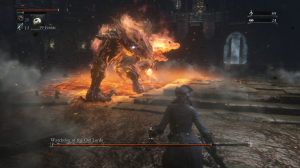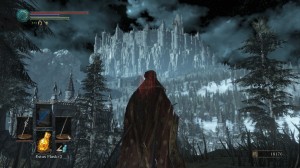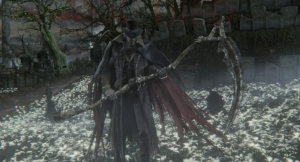It’s time to talk about Soulsborne. We have two spiritual successors to Demon’s Souls that each take the design’s challenging gameplay and level design in different directions. For today’s post, we’re going to attempt to compare the two and see how very similar game design can go in vastly different directions.
Before we begin, it’s important to note the timeline of game releases. While both games have obviously been released after Demon’s Souls, Bloodborne came out after Dark Souls 2; making Dark Souls 3 the most recent in terms of design.
Lore:
I’m not touching this one, as there are people who have spent a lot more time analyzing the lore of these series and have gone into more detail than I ever would.
Basic Mechanics:
Both games make use of the same general control schemes and gameplay structure, but they differ in terms of player options and utility. Playing Dark Souls 3, the player can use melee, range, spells and dodging, riposte and blocking for defense. In Bloodborne, the player has melee, range with their guns, and dodging and staggering for defense.
Dark Souls 3 focuses more on a wide variety of builds and equipment for players to pick what they want. Bloodborne narrows things down in major ways. There are less pieces of gear to wear, with the armor stats negligible compared to Dark Souls 3. Not having shields means that there are no damage absorption stats or being able to really “tank” hits. We can talk about weapons here, but that’s going to be a separate section.
Bloodborne is about melee combat first and foremost. The enhanced dodging was designed to force you to play aggressively.
Staggering enemies is riskier to pull off, as you don’t have the armor to really absorb the damage. The upside is that there are far more enemies susceptible to stagger compared to riposting in Dark Souls 3.
Just playing through the games, Bloodborne’s faster pace feels better compared to Dark Souls 3. In terms of general play, I’m going to give the nod to Dark Souls 3, as the variety of tactics lends itself better when we come to the later topics.
Weapon Design:
Another major break point between the two games, Dark Souls 3 focusing on different weapons broken down by type. Bloodborne has far less weapons, or known as trick weapons, along with ranged options.
In Dark Souls 3, the developers did enhance weapons more compared to previous titles by giving every weapon a special skill. While it’s not ground breaking, it does give the weapons more flavor and the players an additional option while fighting.
Bloodborne’s trick weapons are 100% unique from each other and there are no weapon classes. The variety of weapons range from canes that turn into whips and hammers mixed with swords to name a few. The ability to transform most of the weapons both in and out of combat makes combat more diverse compared to Dark Souls 3.
Even though Dark Souls 3 has more weapons, they are generic within the types for the most part. The only exceptions are the boss soul weapons that add additional functionality to their respective gear.
This is where I give the nod to Bloodborne. I love the crazy weapons of the world and how it gets around having defacto choices for specific classes.
Level Design:
When it comes to level design in a Soulsborne title, we have to talk about three essential elements: The flow of the levels, the environment, and their relation to the world itself. Since Dark Souls, From Software really stepped things up by creating a connective world for all the levels to exist within the same space.
From and environment design standpoint, this is a battle of inches between two amazing games. Both detail a world that is dead or on the verge of dying. So much about what happened can be seen in the destruction around the player.
For me, I’m going to give a slight nod to Bloodborne in this area. The reason is that Bloodborne has more areas taking place within settlements or the major city. There are so many areas that look straight out of a horror movie or post apocalyptic settings. Dark Souls 3 has some amazing areas as well, but I felt Bloodborne was better here.
Let’s talk about the areas themselves. A good level should test the player on a variety of situations, still offer different areas to explore, and be built around shortcuts and alternate paths. The levels of Dark Souls 3 are a lot wider in their design. Bloodborne tends to focus on very specific paths and a narrower feel.
For this one, I’m going to give a point to Dark Souls 3. Bloodborne’s areas tend to feel more corridor-esque compared to Dark Souls 3.
While the larger areas in some sense lack focus, there was more variety in terms of situations to test the player on.
For the final part of this section: How the areas connect to the world around them. Good world design is presenting a place that not only looks like it could exist, but making the areas appear to exist within the same space. There should be multiple ways of getting around, areas connected to each other, and an attempt to avoid dead-end areas.
I’m going to give the nod to Dark Souls 3 for this point. The problem is that Bloodborne’s world doesn’t feel as connected due to the tighter corridors. Because there are fewer checkpoints, you’re going to have to do more walking to and from certain areas.
In Dark Souls 3, there are areas that connect to two or three different ones, and the dead-ends are always at one of the major bosses you have to kill. The wider game space helps out here, and gives the developers an easier time connecting the different areas.
Enemy Designs:
Now we come to the hard part: The enemies themselves. From an aesthetic point of view, Bloodborne is the easy winner in my book. The disturbing looking enemies are probably going to haunt your dreams for some time. The game practically hits every kind of possible phobia of creatures and more.
Now we come to the bosses themselves. Again, we’re comparing two amazing games in terms of design, and it’s neck and neck.
Dark Souls 3 in my opinion has a greater consistency of good bosses. Due to the number of options you had to fight enemies, it afforded more variety in terms of boss designs. Some of my favorites were the unnamed king, the final boss and champion Gundyr.
The problem with Bloodborne in my opinion goes back to the lack of options.
You are limited by how you fight the bosses because combat was built primarily around melee. Variety of enemies doesn’t matter if you only have one or two methods of winning.
With that said, I do feel that Bloodborne’s bosses do hit higher highs than Dark Souls 3. The hunter fights and Ludwig were some of the best. What drops Bloodborne down a notch was the camera getting in the way for the larger fights.
For me, I’m going to give the slight nod to Dark Souls 3, as a good consistency of challenge is very hard to get right.
Who’s the Winner?
So, which game is better in my opinion? From a moment to moment standpoint, Bloodborne’s feel of combat and weapon variety were amazing, but I think overall Dark Souls 3 was slightly better. With that said, a Bloodborne 2 iterating on the previous’ design could be fantastic.
In the meantime, my next action game focus is going to be Nioh, and that’s going to be an interesting game to add into the mix.
What did you think of Bloodborne vs. Dark Souls 3? Let me know in the comments.
If you enjoyed the post, be sure to check out Patreon campaign to help support Game-Wisdom.






